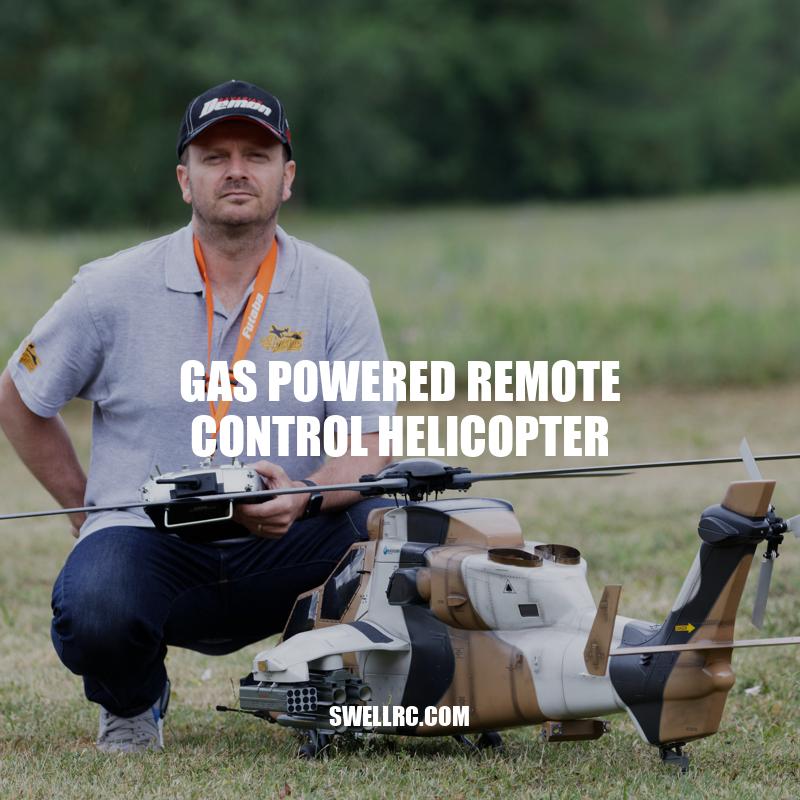Gas-Powered RC Helicopters: High-Performance and Longer Flight Times
Gas-powered remote control helicopters offer an exciting and challenging hobby for enthusiasts willing to put in time and effort to master the complexities of flying and maintaining these vehicles. Compared to electric or battery-powered models, gas-powered helicopters offer advantages such as longer run times, greater power, and more flexibility in flight patterns. These benefits make gas-powered RC helicopters a popular choice among hobbyists who enjoy the challenge of mastering both the technical and practical aspects of this pursuit. Understanding how these helicopters work, their maintenance requirements, and the steps involved in setting them up is essential for enthusiasts looking to take full advantage of this rewarding and exciting hobby. In this article, we will cover key information on gas-powered remote control helicopters, including how they work, how to maintain them, how to set them up, and essential tips for flying them safely and confidently.
How Gas-Powered RC Helicopters Work
Gas-powered RC helicopters function through the combustion of nitro fuel or gasoline in a two-stroke engine that powers the rotor blades. More specifically, the engine operates by mixing fuel with a mixture of nitro and oil in a combustion chamber, pumping in air and igniting the mixture via a glow plug to create power that is then transferred to the main rotor blades. Some things to note about gas-powered RC helicopters include:
- These helicopters have greater power than electric or battery-powered models
- They have longer run times due to their larger fuel capacity and fuel efficiency
- They require a separate fueling station, which can be more complex and time-consuming to set up
For more detailed information on how gas-powered RC helicopters work, the website RC Helicopter Fun offers a comprehensive guide on everything from engine types and fuel options to the principles of how these helicopters operate.
How does a RC helicopter work?
RC helicopters work by using a series of rotors to lift and maneuver the aircraft. The rotors are controlled by a transmitter that sends signals to the helicopter’s onboard receiver. The receiver then translates those signals into movement of the rotors, allowing the helicopter to fly forward, backward, up, down, and side to side.
RC helicopters use various mechanisms to achieve lift and movement, including:
– Collective pitch control: Adjusts the angle of the rotors to increase or decrease lift.
– Swashplate: Controls the angle of the rotors for forward, backward, and side-to-side movement.
– Tail rotor: Provides control over the helicopter’s heading and helps counteract torque from the main rotor.
RC helicopters come in a wide range of sizes and styles, from basic toy models to advanced hobby-grade models with complex controls and features. Hobby-grade models often require assembly and maintenance, but offer greater control and precision in flight.
If you’re interested in learning more about RC helicopters, check out hobby and toy stores, as well as online retailers that specialize in RC vehicles and accessories.
Maintenance of Gas-Powered RC Helicopters
Maintaining a gas-powered RC helicopter properly is critical to ensure that it remains in safe and optimal condition. Some maintenance tasks to perform regularly include:
- Cleaning the helicopter – After each use
- Checking fuel and oil levels – Before each use
- Inspecting parts for wear and tear – After every few flights
Additional maintenance tasks to consider include applying lubricant to the engine, replacing worn parts, and ensuring that the helicopter is stored in a dry, clean space.
Performing regular maintenance not only increases the lifespan of the helicopter but also helps prevent accidents and promotes safe flying. For more tips on maintaining your gas-powered RC helicopter, check out the website Helifreak, which offers a comprehensive guide covering everything from basic maintenance tasks to engine tuning and troubleshooting.
Do Helicopters Require a Lot of Maintenance?
Yes, helicopters require a lot of maintenance to ensure safe and efficient operations. Here are some quick points to consider:
- Helicopters require regular inspections, maintenance, and repairs to ensure they meet safety standards set by regulatory agencies.
- The number of hours flown determines the frequency of inspections and maintenance required.
- Regular maintenance includes changing oil and other fluids, replacing worn parts, and inspecting the engine, transmission, rotor blades, and other critical components.
- It is crucial for helicopter owners and operators to stay up-to-date on maintenance schedules and keep accurate maintenance records.
If you are interested in learning more about helicopter maintenance, you can check out the websites of helicopter manufacturers, such as Airbus Helicopters and Bell Helicopter, or organizations like the Helicopter Association International.
Setting up a Gas-Powered RC Helicopter
Setting up a gas-powered RC helicopter requires some initial steps to ensure that the helicopter is properly configured and ready to go. Follow these tips to set up your gas-powered RC helicopter:
- Read the manual carefully and follow the instructions closely.
- Inspect the helicopter and check for any damages or issues.
- Install the fuel tank and ensure it is secure.
- Fill up the tank with the correct fuel and oil mixture as recommended by the manufacturer.
- Secure the rotor blades to the helicopter.
- Turn on the transmitter and then the helicopter, following the manufacturer’s instructions.
- Perform a test flight to ensure that the helicopter is properly configured and safe to fly.
It’s important to note that every gas-powered RC helicopter is different, and there may be additional steps or considerations to take into account depending on your specific model. Don’t hesitate to seek out professional help or consult with experienced pilots if you’re unsure about anything.
For more detailed tips and guides on setting up and tuning your gas-powered RC helicopter, check out the website AMA (Academy of Model Aeronautics), which offers a wealth of resources for RC pilots of all skill levels.
What voltage should a RC helicopter be?
The voltage required for an RC helicopter depends on its size, weight and motor type. Typically, smaller helicopters require 3.7-7.4V while larger ones need 11.1-22.2V.
Other important factors to consider are the battery capacity and C-rating needed to deliver the required current. Always refer to the manufacturer’s specifications for the correct voltage and battery type.
If you’re looking for RC helicopters or related products, check out hobby shops or online retailers such as Amazon, HobbyKing, and Tower Hobbies.
Top Gas-Powered RC Helicopter Models
If you’re looking for high-performing gas-powered RC helicopters, there are plenty of great options on the market. Here are some of the top models to consider:
1. Synergy N7
- Large and powerful helicopter, perfect for experienced pilots.
- Advanced flybarless rotor head for precision control.
- Carbon fiber frame for strength and durability.
- Compatible with a range of gas engines.
- Price: around $1,300.
2. Align T-Rex 700XN
- Powerful and responsive helicopter with a sleek design.
- Includes a 1080P HD camera for aerial photography or videography.
- Advanced flybarless system for smooth flying and precision control.
- Built-in governor for stable power delivery.
- Price: around $1,200.
3. Goblin Black Thunder T-Line
- Advanced and high-performing helicopter with a sleek design.
- Triple bearing-supported, oversized tail rotor for better stability and control.
- Aerodynamic canopy design for better wind resistance and stability.
- Carbon fiber frame for strength and durability.
- Very high power to weight ratio.
- Price: around $1,200.
Keep in mind that there are many other excellent gas-powered RC helicopter models on the market, and each one has its unique features and benefits. Do your research and consider your own needs and flying goals when making a purchase.
For more information on RC helicopter models and reviews, check out the website RC Helicopter Fun, which offers a wealth of resources and information for RC pilots of all levels.
What is the best RC helicopter in the world?
It’s difficult to determine the best RC helicopter in the world as there are so many different types and models available. It ultimately depends on your personal preferences and what you are looking for in a helicopter. However, there are a few top-rated options to consider:
- The Blade mCP X BL2 is a popular choice for indoor flying due to its durability and agility.
- The DJI Mavic Air 2 is a high-end drone that offers impressive camera capabilities and a long flight time.
- The WLtoys V911S is an affordable option for beginners looking to get into the hobby.
It’s important to do your research and read reviews before making a purchase to ensure you find the perfect RC helicopter for you.
Tips for Flying Gas-Powered RC Helicopters
Flying gas-powered RC helicopters can be a lot of fun, but it also requires some skill and preparation. Here are a few tips to help make your flights a success:
1. Practice in open spaces
- Find an open field or similar space where you can safely practice flying your helicopter without running into buildings, trees, or other obstacles.
- Clear any debris or obstacles before beginning your flight.
2. Assess flying conditions with weather tools
- Check weather reports, wind gauges, and other tools to assess flying conditions and determine whether it’s safe to fly your helicopter.
- Be aware of potential hazards like gusty winds or precipitation.
3. Avoid obstacles and interference
- Avoid obstacles like power lines, trees, buildings, and other structures that could damage or interfere with your helicopter.
- Stay clear of other people, animals, or vehicles that might interfere with your flight.
4. Be mindful of safety and responsible flying
- Always follow safety guidelines and regulations when flying your RC helicopter.
- Be respectful of other pilots and members of the public who may be in the area.
- Consider joining a RC helicopter flying club to learn more about safety and responsible flying.
With these tips, you can enjoy a safe and successful experience flying your gas-powered RC helicopter. For more advice and tips on RC helicopter flying, check out the website Model Aviation, which offers a variety of resources and information for RC pilots of all levels.
Are RC helicopters hard to fly?
Yes, RC helicopters can be quite challenging to fly, especially for beginners. Unlike RC planes, helicopters have a complex control system that requires more skill and experience to operate effectively. However, with some practice and patience, anyone can learn how to fly an RC helicopter.
Here are some factors that can make RC helicopters difficult to fly:
- The control system involves not only the typical up/down, left/right movements but also forward/backward, spin, and tilt.
- The helicopter’s movements are affected by wind and other weather conditions, which can be more difficult to predict and control than with planes.
- The helicopter’s weight and size can affect its handling, making it challenging to maneuver in tight spaces or around obstacles.
If you’re looking to learn how to fly an RC helicopter, it’s best to start with a beginner-friendly model and take some time to practice in an open, safe space. Websites like rchelicopterguide.com offer comprehensive guides and product recommendations to help you get started.
Conclusion
Gas-powered remote control helicopters are a magnificent piece of technology that allows users to enjoy the thrill of flying a helicopter with minimal financial expense. Gas powered RC helicopters have improved efficiency and longevity, making them a better purchase option for users who want to own a remote control helicopter for more extended periods. Despite the benefits of gas-powered RC helicopters, they require more maintenance than their battery-powered counterparts, and beginners need to handle them with care.
Final Thoughts
Overall, a gas-powered remote control helicopter is a stunning piece of technology entertain both beginners and experts alike. While they require more maintenance, the benefits they offer in terms of performance, flexibility, and longevity make it a worthwhile investment. By following the tips outlined in this article, users will have an enjoyable experience with their gas-powered RC helicopters. Don’t forget to research the models, ask experts for help, and stay up to date on safety guidelines and regulations. So, what are you waiting for? Start flying with a gas-powered remote control helicopter today!



